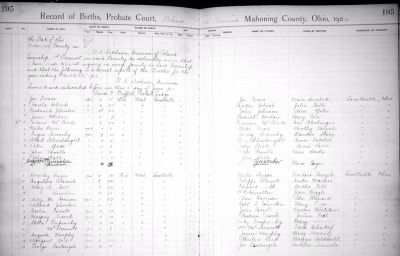When your ancestors settled in America, many of the important events that happened in their lives and their families’ lives were recorded in U.S. vital records. The main types of records that may yield valuable information about your ancestors are marriage, birth and death records. Each of these types of records has a distinct advantage in discovering details of your family history. It is also beneficial to know when vital records were routinely created and where to look for them. Like other types of records, finding your Italian ancestors’ records are sometimes challenging so we are going to look at those challenges and how to overcome them. Our focus this month will be on U.S. birth records.
You might be thinking how can a U.S. birth record be useful for an Italian ancestor? The answer is that even though your Italian ancestor was not born in the U.S., if he or she had children born here, those records may offer valuable information such as an Italian ancestor’s original name (this is particularly useful for your female ancestors), a date of birth derived from their age at the time of the child’s birth and where the family may have been living. Knowing where ancestors lived helps you track down even more information for your family history.
That is the good news about birth records. The bad news is that the earlier they are, the harder they may be to find. Mandatory registration of birth by the states did not happen until the early 1900s and, when it did occur, there is quite a bit of variation from state to state. For example, in the state of Ohio, mandatory birth registration began after December 20, 1908. However, some local jurisdictions such as counties or cities may have recorded births earlier than the state required it. To find out if a record exists, you will need to check their website or call. Another issue you might encounter when you request a record is confidentiality. In some states records remain confidential for up to 100 years. In other states you may have to prove that you are related to the individual or that they are deceased before a copy of the record will be released to you. Don’t let these issues stop you; it just might take a bit of work to find an older record.
Some records have been digitized and can be viewed on www.familysearch.org (free) or at www.ancestry.com (by subscription or viewable at a library or Church of Latter Day Saints’ Family History Center). Additionally, some local historical or genealogical societies may also have records. An internet search for these societies in the area where your ancestors lived will help you locate their contact information.
One of the biggest benefits to finding a child’s birth record is it often contains a mother’s maiden name. This is particularly useful for researching your female Italian ancestors. In Italy, women did not change their names upon marriage, but here in the U.S. they did. As a result, you may not know great-grandma’s name if you have only U.S.-based records for her.
When searching for a birth record, you may need to be creative. Normally, a child will be listed under the surname of the father. But if you cannot find the record with the expected surname, try searching under the mother’s maiden name if you know it. You might be surprised to find that a child was born before marriage or was actually raised by a stepfather. If a maiden name search does not produce results, try searching by all-known spellings of the surname. Finally, sometimes a surname is so different than expected, that the best way to search is by first name and the date of birth.
Occasionally when searching for early family birth records, you may come across a birth record of a child that you do not recognize from your family tree. There are three common possibilities as to the fate of the child. The child did not survive into adulthood, was adopted out of the family or used a different first name. Whenever I find these children, I then look to the census records over the years to narrow down which situation may apply or find a possible time of death in order to search for a death record to determine what actually happened to the child. For adoptions, keep in mind that Informal adoptions were not uncommon. A family acquaintance of mine was given away to another family to raise when her mother died shortly after her birth and her father felt overwhelmed raising four children on his own. In this case, no adoption papers were signed and the little girl grew up using her adoptive family’s surname.
As you can see, there is value in locating the records of the children of your ancestors even though the child might not be a direct ancestor. These records help fill out your tree and document your family’s history. Next month we will explore U.S. church records.



